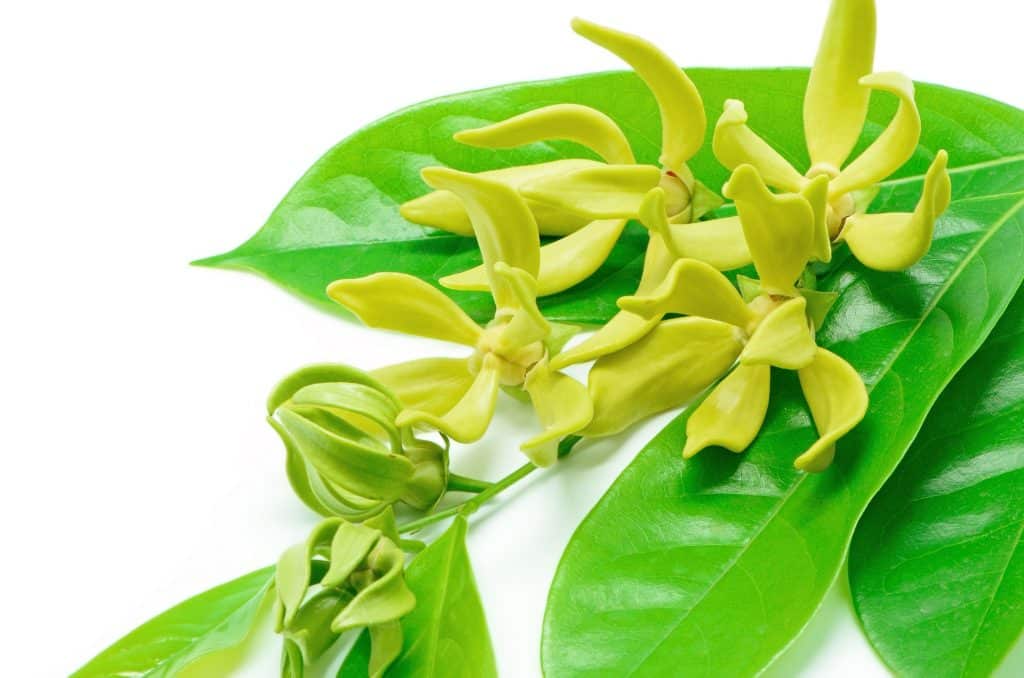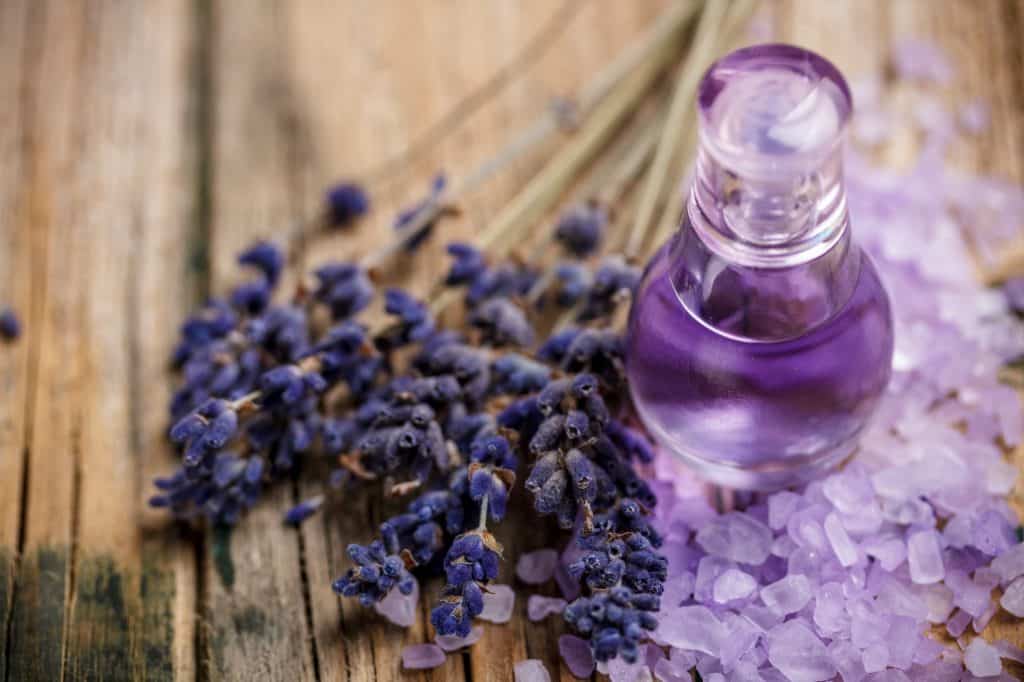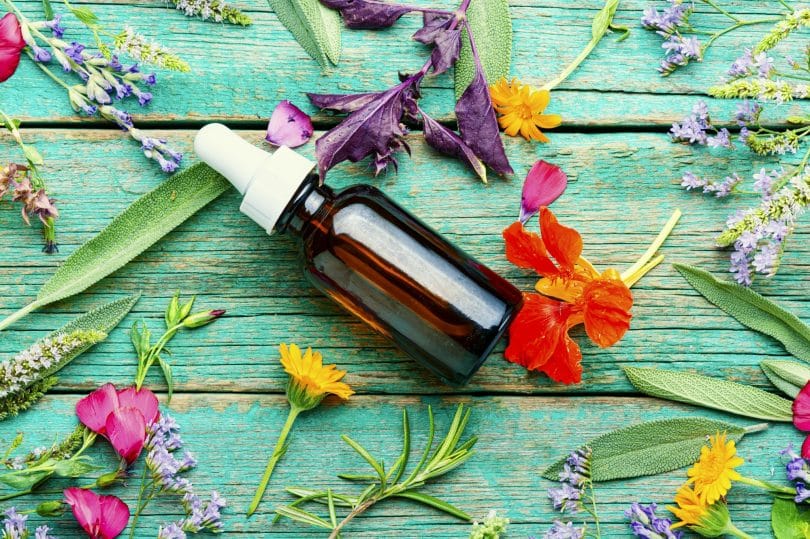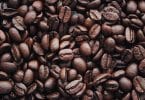Ylang-Ylang essential oil is an exotic, intensely floral scent that might seem tricky to pair with other oils, but goes lovely with quite a variety of scents.
In this post, we’ll be covering a bit about Ylang-Ylang and its uses, as well as how to make Ylang-Ylang perfume that you’re sure to fall in love with.
If you’re curious about having something to compare your homemade perfume to, Etsy has some great Ylang Ylang perfume products to test out.

What Exactly Is Ylang-Ylang?
Ylang-Ylang is a yellow, star-shaped flower from the Cananga tree, found in the Philippines, Malaysia, Indonesia, and some parts of Australia.
The essential oil of the flower can smell intensely sweet and floral, while the “complete” oil tends to be a bit more rounded and subtle. (The most potent, sought-after Ylang-Ylang oil is often the one that goes through a distillation process lasting about 30 minutes to an hour—the fractions after that aren’t quite as potent but still fit most general uses.)
Ylang-Ylang is an oil that is frequently chemically altered (or even mixed with flowers from the Artabotrys suaveolens, Cananga oil, and lavender oil). It’s important to buy from a source you trust and who knows not just the origin, but the distillation methods as well.
While most of these oils aren’t inherently bad or harmful, you’re just not getting the same thing. Some producers are a little more transparent about these practices, labeling them as Ylang-Ylang blends and not just Ylang-Ylang oil.
Most pure Ylang-Ylang oils have a distinctly sweet and floral smell, with hints of spicy, woodsy, medicinal notes. (You might notice some likeness to Jasmine, Neroli, and some variants of Lavender oil.)
How to Make Ylang-Ylang Perfume
Ylang-Ylang isn’t typically used as a base, but it can certainly hold its own if you want to pair it with spicy or citrus oils! It typically finds itself in the “middle” of a blend and pairs well with bases like patchouli, Balsam of Peru, ginger, vetiver, and sandalwood.
It goes beautifully with floral and citrus top notes like lavender, lemongrass, bergamot, or any minty oils. Ylang-Ylang also plays nicely with other floral, spicy middle notes like chamomile, clary sage, and rose.
If you’re looking for something a little different, Ylang-Ylang has some spicy undertones that pair well with things like anything that smells like anise or fennel and spicy things like clove, cinnamon, cardamom, ginger, and nutmeg.
As for making the actual perfume, we’ll get into that now! Here’s how to make your own blend:
Using Alchohol
The majority of your perfume will be either a carrier oil or a combination of alcohol and water if you want something lighter. For our purposes, I don’t recommend alcohol—oils are much easier to do “right” and they’re more gentle on the skin.
If you do want to use alcohol and water, just make sure you have the right proportions. To make things simple, you want at least 25-30% of your blend to be high-proof alcohol (a bottle of Everclear will do the trick). If not Everclear, just make sure it’s a minimum of 120 proof, preferably 190.
The other 70-75% will be your water and essential oil mixture. (Essential oils will be a very small part of this.) If you’re using a 2% dilution rate as recommended here, you would use .08 oz of essential oil, 2.92 oz of water, and 1 oz of alcohol.
For the purpose of making sure your oils mix or “set,” you need the highest proof you can get. I won’t use anything but 95%, especially for thicker, resinous oils that never completely disperse properly. You can be a little more lenient on lighter oils that flow easily—think citrus oils and lighter floral oils.
I do recommend using weight, not volume, where water is involved, as well as sanitizing your space before you make your blend. Water isn’t the most friendly thing to work with and you often have to worry about the presence of microbes (hence the importance of strong alcohol).
Using Carrier Oils
There’s not as much pressure to preserve your mixture with oils. While oils can go rancid quickly if they’re not stored properly, you don’t have to worry as much about microbes or having a preservative system for small amounts of oil-based mixtures. (In general, storing them in a cool, dark place and not leaving them out in the heat will make sure they stay good for months.)
I prefer to use almond, jojoba, or MCT oil (also labeled fractionated coconut oil), which are very thin and can be easily used in roller bottles and even atomizers without clogging them. Olive oil and other heavy oils tend to have a bit of fragrance of their own and might clog the nozzle.
I like to get the 30 ml roller bottles and put in about 12 drops of essential oil blend (I use a bit more) and fill the rest up with a carrier oil. (For oils I’m selling, I still do weight-based measurements for consistency—not so much for my own personal blends.)

Ylang-Ylang Essential Oil Blends
Here are three of my favorite blends using Ylang-Ylang:
Spring Ylang
- 4 drops Ylang-Ylang
- 6 drops Lavender
- 2 drops Orange
Earthy Relaxation
- 3 drops Patchouli
- 2 drops Sandalwood
- 5 drops Ylang-Ylang
- 2 drops Clove
Floral Spice
- 4 drops Balsam of Peru
- 3 drops Ylang Ylang
- 2 drops Cinnamon
- 3 drops Anise
Use these with the above proportions for oil. For alcohol/water-based blends, I recommend weighing your bottle, zero the scale with the bottle on it, and weigh your oil as you put it in, since they tend to stick to surfaces a bit more than water and alcohol.
Looking for More Information on Essential Oil Blends?
Check out some of our guides to help you make your own blends, as well as some other projects you can use them in:
- Essential Oil 101
- How to Make Roll-On Perfume (More tips on how to create your own blends using top/middle/base notes)
- DIY Bath & Body Products
- Essential Oils for Candle Making







